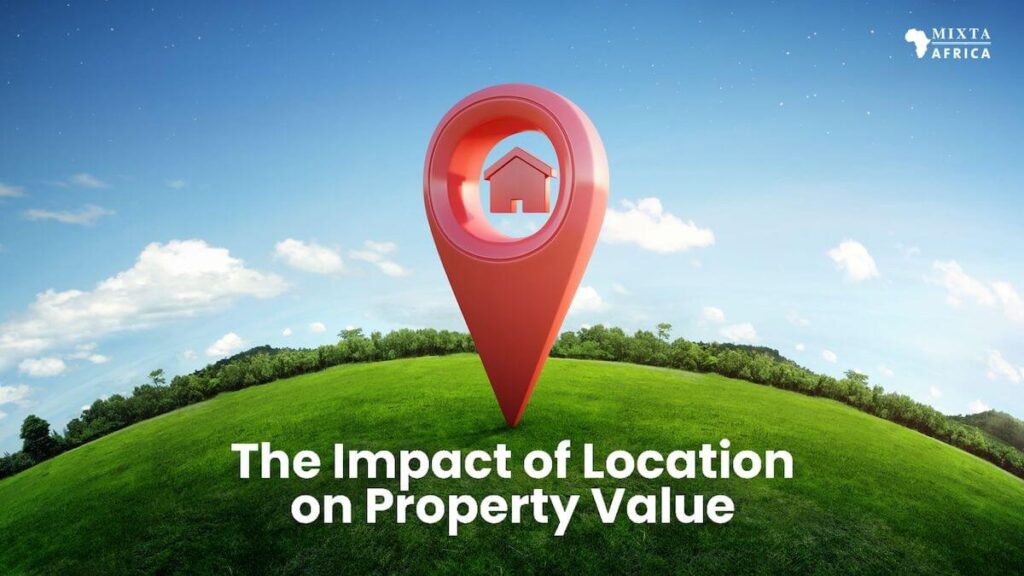Have you ever wondered why some properties, even smaller or older ones, fetch a higher price than others that are bigger or newer? Well, it all boils down to that golden rule in real estate: “location, location, location”.
But why does location matter so much? Think of it this way: you’re not just buying a property, you’re buying a place in a community, a slot in a school district, a commute time to work, a level of safety, and an array of amenities – or lack thereof. All these factors tied to your property’s location can either increase its desirability and therefore its value or diminish it.
That’s why in some neighborhoods, a compact mid-century home might command a higher price tag than a sprawling new build in a less coveted locale. It’s the lure of the location, the invisible yet palpable factors that make an area tick, that dictates this price variation.
This blog post aims to dissect the significant influence of location on property value. Whether you’re a first-time buyer, a seasoned investor, or simply someone interested in understanding the dynamics of the real estate market, you’re in the right place.
Access to Amenities and Services
Picture yourself on a regular day. You might need to drop your kids off at school, get groceries, swing by the doctor’s office, maybe pick up a latte on your way back home, or perhaps enjoy a quiet afternoon in the local park. Wouldn’t life be so much easier if all these places were just a short walk or drive away?
Indeed, the proximity to essential amenities such as schools, parks, shopping centers, and medical facilities significantly boosts a property’s value. Imagine having the privilege to choose the school where your kids will be educated, being able to do your weekly shopping without a long commute, or having the luxury to stroll down to a beautiful park right in your neighborhood. This convenience is invaluable and a crucial factor potential homeowners consider.
Remember that good school district we talked about? Homes located in these areas often command higher prices because education is a priority for many families. They’re willing to pay a premium for the opportunity to send their kids to top-rated schools.
And, it’s not just about schools and supermarkets. The availability of essential public services, such as efficient public transportation, plays a significant role in determining a property’s value. Living near a transit hub, like a subway or bus station, can be a huge perk, especially in bigger cities where driving can be a hassle. Reliable public transportation not only means convenience, but it also implies savings on transportation costs and commute times.
In the grand scheme of things, these amenities and services form an intricate web that significantly impacts our daily lives. When these essentials are within arm’s reach, it enhances our quality of life, and that’s exactly what you’re investing in when you buy a property in such a location. The inherent value of such convenience is ultimately reflected in the property’s price tag. So, in the realm of real estate, it’s safe to say that convenience is indeed a currency!
Neighborhood Characteristics
Have you ever taken a leisurely drive through a neighborhood and found yourself immediately attracted to its vibe? Maybe it’s the tree-lined streets, the quaint historic architecture, or the sparkling cleanliness that appeals to you. These seemingly minor details play a crucial role in creating the overall character of a neighborhood, and you guessed it right, they significantly affect property value.
Let’s start with the basics. Cleanliness and safety are foundational elements that determine a neighborhood’s desirability. When streets are clean, well-lit, and free of litter, they indicate a sense of community pride and civic responsibility. Similarly, a neighborhood with low crime rates, where residents feel safe to take evening strolls or let their kids play outside, is bound to be more desirable. This sense of security and cleanliness creates a pleasant living environment that potential homeowners are willing to pay a premium for.
Community involvement is another strong influencer. Active neighborhood associations, frequent community events, and the general feeling of camaraderie among residents give the place a warm, friendly vibe. When you buy a property in such a neighborhood, you’re not just investing in bricks and mortar, but also in a sense of community, which greatly adds to your quality of life.
Then come the delightful extras – tree-lined streets, historic architecture, high-end restaurants, or maybe a neighborhood famous for its artisanal shops. These features give a neighborhood its unique charm and identity. Picture this: walking down a tree-canopied street, admiring the historic homes with their stunning architectural details, perhaps stopping by a neighborhood café for a quick bite. Doesn’t that sound wonderful?
Features like these can significantly enhance the aesthetic appeal of a neighborhood, making it a coveted place to live. This attractiveness, in turn, translates to higher property values. In essence, when you’re buying property in such a location, you’re buying a lifestyle, and that comes with its own price tag.
Economic Factors
It’s time to turn our focus towards something a bit more macro: economic factors. While quaint cafés and clean streets do add a charm to your neighborhood, the larger economic health of your location holds a mighty sway over your property’s value.
Let’s consider job opportunities first. A robust job market is a potent magnet for people. After all, we all need a source of income to sustain our lifestyles. Locations with a plethora of job opportunities across diverse industries naturally attract a larger workforce. And guess what? These workers need places to live. As demand for housing in such areas rises, so does the property value.
Take the example of tech hubs like Silicon Valley. The concentration of high-paying jobs in the tech industry has led to a significant increase in housing demand, pushing property values sky-high. When you buy a property in a location with a thriving job market, you’re essentially tapping into the economic vibrancy of the area, which can be a profitable venture.
Moreover, the overall economic growth of an area is a significant factor as well. Locations experiencing economic expansion often witness infrastructure development, improved public services, and a general upliftment in the standard of living. These changes can make the area more appealing to potential homeowners and investors, driving up property values.
Think about areas that are pegged as future ‘growth corridors.’ They are often earmarked for development projects like new commercial complexes, transport infrastructure, or educational institutions. The anticipation of these developments creates a ripple effect on property values, causing them to increase even before the actual development takes place.
Environmental Factors
Environmental factors, both beneficial and detrimental, carry significant weight in the real estate game. Let’s navigate through this terrain to understand how the natural world around us influences our property values.
Let’s start with the picture-perfect side of nature. Scenic views, waterfront properties, and access to outdoor recreation – these are the golden tickets in the real estate market. A home that overlooks a serene lake or a property at the foot of a picturesque mountain commands a premium price. These homes aren’t just selling a roof over your head; they’re offering a slice of natural beauty, a daily panorama of nature’s art. Imagine waking up to the view of a tranquil lake or going for a jog on a beach just a stone’s throw away from your home. These experiences enrich your lifestyle and thereby increase your property’s value.
Furthermore, properties offering easy access to outdoor recreation, such as hiking trails, national parks, or even charming picnic spots, also tend to be more valuable. They cater to the residents’ active side, allowing them to enjoy their favorite activities without venturing far from home.
However, like two sides of a coin, nature also has its challenges. Properties in areas prone to natural disasters like floods, wildfires, or earthquakes might struggle with lower property values. The risk of damage and the potential higher insurance costs make these properties less attractive to buyers, thereby reducing their market value.
Pollution is another critical environmental factor. Areas with cleaner air, lower noise pollution, and limited industrial impact are considered more desirable, leading to higher property values. No one dreams of a home with smoggy air or constant noise. Clean, quiet neighborhoods offer a healthier living environment, a benefit that buyers appreciate and are willing to pay for.
Crime Rates and Safety
It’s a universal truth – everyone wants to live in an area where they feel safe and secure.
High crime rates are a massive deterrent for potential homeowners. Crime in a neighborhood paints a picture of insecurity, making residents constantly worry about their safety and that of their loved ones. This fear can cause families to move away, reducing demand for properties in the area, which inevitably leads to a drop in property values.
Imagine this: after a long day at work, you return to a home in a neighborhood where you constantly worry about break-ins or vandalism. Doesn’t sound like the peaceful haven you want to come back to, right? That’s precisely how potential homebuyers feel when they encounter areas with high crime rates. They’re likely to steer clear, which reduces demand and subsequently pulls down property prices.
On the flip side, a neighborhood boasting low crime rates and a reputation for safety can significantly boost property values. When you invest in a property in a safe area, you’re buying more than a house. You’re buying peace of mind, a sense of security, and a comfortable environment for your family. These intangible yet crucial aspects enhance the appeal of a property, making it a hot commodity in the real estate market.
Safety is reflected not just in the crime rates but also in the community’s efforts toward maintaining a secure environment. A neighborhood watch program, well-lit streets, effective local law enforcement, and engaged residents all contribute to creating a safe and secure living space. These factors project an image of a community that cares for its residents’ well-being, which can be a significant draw for potential homeowners.
Future Development Plans
Any neighborhood or city isn’t a static entity; it’s always evolving. New infrastructure, businesses, or public transportation expansions can bring about significant changes, all of which have a profound impact on property values.
Future development plans for a location can be a game-changer in the real estate market. Think of them as a window into the future potential of an area. They indicate that the place is on an upward trajectory, signaling potential growth and prosperity.
Let’s talk about infrastructure improvements first. These could include anything from new roads and bridges to upgraded utility systems or even a new public park. Improved infrastructure enhances the quality of living in the area, making it more convenient and desirable. As a result, property values in the vicinity are likely to experience a boost.
Consider the impact of a new highway that reduces commute time or a revamped sewage system that solves water-logging issues. These upgrades make life easier for residents and draw more people to the area, creating a higher demand for properties and thus increasing their values.
Next, the establishment of new businesses can also give property values a nudge upward. New businesses mean more job opportunities, drawing a larger workforce to the area. Plus, the arrival of popular retail stores or trendy restaurants can make the location more appealing, which can also add a premium to property prices.
Let’s not forget the expansion of public transportation. An extension of a subway line or new bus routes can make commuting a breeze for residents. In bustling cities where traffic is a constant challenge, easy access to public transportation is a massive plus point. It makes the location more accessible and connected, which is a significant draw for homebuyers and renters alike, pushing up property values.
Conclusion
Drawing our journey to a close, the paramount role of location in determining property value is unmistakable. A myriad of factors, including neighborhood characteristics, economic and environmental factors, crime rates and safety, and future development plans, all play their unique tune in the symphony of property valuation.
Remember, each location offers its unique blend of these factors, creating a distinct narrative that shapes property values. So, when you’re on the hunt for your next property investment or home, allow the attributes of the location to guide your decision.
In the dynamic world of real estate, your home is more than just a physical structure; it’s an investment in a location and its potential. Thus, understanding the rhythm of your desired location can pave the way to a rewarding investment. Always remember, in real estate, location isn’t just a factor, it’s the factor.








